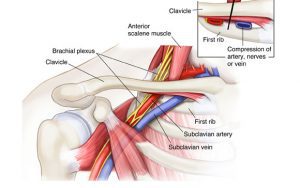What is thoracic outlet syndrome?
The thoracic outlet is the space between your clavicle (collarbone) and your first rib, it is a packed pathway full of nerves, blood vessels and muscles. Thoracic outlet syndrome is an array of disorders that occur when there is compression, injury, or irritation of the nerves and/or blood vessels in the thoracic outlet. This commonly causes pain in your shoulders and neck.

Causes of thoracic outlet syndrome
To put it simply, the cause of thoracic outlet syndrome is the compression of the nerves and blood vessels in the thoracic outlet. Although the causes of the compression varies from case to case and can include:
● Anatomical defects (this can be anything from an extra rib located above your first rib or an abnormal first rib);
● Trauma (traumatic injuries can compress your thoracic outlet);
● Poor posture;
● Pressure on your joints;
● Overuse of the shoulders and arms;
Signs and symptoms
Thoracic outlet syndrome will typically present neck, shoulder and arm pain, and potentially numbness in your arm and hands. The symptoms vary depending on which nerves or blood vessels are compressed. Some other common symptoms include:
● Arm pain and/or swelling;
● Numbness and/or tingling in your fingers;
● Weak or no pulse in the affected arm;
● Discolouration or lack of colour in your hands or fingers;
● Arm fatigue;
● Swelling in your arm and/or shoulder;
● Cold fingers, hands or arms.
Diagnosis and treatment of thoracic outlet syndrome
Pinpointing the exact cause of thoracic outlet syndrome can be difficult with the range of causes and disorders that fall under the umbrella of the condition. Generally, a physician will start with a physical examination and analysis of your medical history. Other tests can include a provocation test, which is designed to reproduce your symptoms to identify their cause. Like the majority of injuries imaging and/or nerve study tests may be necessary to narrow down the cause of your symptoms.
Thoracic outlet syndrome treatment depends on the source of your case. Usually, conservative management with physiotherapy and behaviour/postural education is best. Other potential treatments include, but are not limited to:
● Rest;
● Physical therapy;
● Anti-inflammatory medications;
● Pain medications or muscle relaxants;
● Blood-clot dissolving medications;
● Surgery – Transaxillary approach or Supraclavicular approach or Infraclavicular approach.
Prognosis
Most symptoms can be resolved through conservative management with physio and behaviour/postural education. A period of 6 months or longer may be necessary for you to recover fully.
If you need help with pain or immobility to get you moving again, or need a tailored exercise program, book in for your treatment now with one of our exercise, physio, or pain specialists via 1300 012 273 or head to our website and book a session at your nearest clinic.

